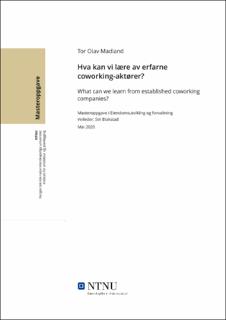| dc.contributor.advisor | Blakstad, Siri | |
| dc.contributor.author | Madland, Tor Olav | |
| dc.date.accessioned | 2021-09-28T17:22:33Z | |
| dc.date.available | 2021-09-28T17:22:33Z | |
| dc.date.issued | 2020 | |
| dc.identifier | no.ntnu:inspera:58784277:21529349 | |
| dc.identifier.uri | https://hdl.handle.net/11250/2784260 | |
| dc.description.abstract | Sammendrag
Denne oppgaven tar sikte på å besvare følgende problemstilling: Hva kan vi lære av etablerte coworking-aktører? Coworking er et relativt nytt konsept innen kontoreiendom, men i Oslo frykter eksperter at det allerede finnes en overetablering av slike konsepter, noe som har resultert i et stort prispress og pressede marginer for bransjens aktører. Formålet med denne oppgaven er derfor å forsøke å kartlegge hva som kreves for å lykkes i dette vanskelige markedet. I all hovedsak handler coworking om å selge fleksible medlemskap til mindre bedrifter som da får tilgang til et åpent kontorfellesskap og lokalets fasiliteter. Her kan leietakerne dele kostnader og ressurser samtidig som de får en arena for sosialisering og samarbeid.
Oppgavens problemstilling vil bli belyst fra ulike ståsteder. Forskningsspørsmålene tar sikte på å studere aktørenes konsept, medlemmenes brukerpreferanser og hvordan et coworking kontor kan oppnå høy brukskvalitet. Undersøkelsene vil bli utført hos seks aktører, valgt etter å ha innfridd satte kriterier. Det er utført litteratursøk, dybdeintervju, ekspertintervju, spørreundersøkelse av brukerne og en usability undersøkelse for å besvare problemstillingen og forskningsspørsmålene.
Det første forskningsspørsmålet om aktørenes konsept viste at aktørene hadde svært ulike konsepter. Aktørene varierer seg i mellom når det kommer til lokalitet, kontorløsninger, type fellesareal, eksklusivitet, pris, fleksibilitet i medlemskapene og lokalene, inntektskilder og syn på community . Den avgjørende faktoren for variasjonene skyldes brukergruppen og hvem aktørene forsøker å treffe med sitt konsept. Ved å tilrettelegge for sine respektive målgrupper har aktørene styrkede forutsetninger for et høyt utleiebelegg.
Spørreundersøkelsen og det andre forskningsspørsmål om brukerpreferanser innen coworking viste at medlemmer i coworking-kontor stort sett verdsetter de mest grunnleggende tingene. Høyhastighets internett, beliggenhet og gode møte og konferanserom er de viktigste fasilitetene og funksjonene innen coworking. Typiske coworking funksjoner som mentorordning, el-sykkel og faglige arrangementer scorer i andre enden.
Det tredje forskningsspørsmålet tok for seg coworking-kontoret som en arbeidsplass. For å tilrettelegge for coworking og oppnå høy brukskvalitet anbefales det å kombinere åpent kontorfelleskap med aktivitetsbaserte løsninger. Spesielt viktig er det å tilby en rekke fasiliteter og soner slik at brukeren har flest mulig alternativer. Uten fast plass kan følelsen av tapt kontroll føre til stress og misnøye hos brukeren, noe som kan bekjempes med høy grad av alternativer, brukermedvirkning og justerbare lokaler. Ellers er byggets lokasjon og tilgjengelighet av stor betydning. | |
| dc.description.abstract | Abstract
This thesis addresses the following question: “What can we learn from established coworking companies?”. Coworking is a fairly new concept in the office rental market, but experts are already saying there are too many coworking spaces in Oslo. As a consequence of the fierce competition the rental prices and margins are being kept very low. The goal of this thesis is therefore to discover what it takes to succeed in this competitive market.
Coworking in general is about selling flexible memberships to smaller businesses. In return they get access to an open office space and all of the facilities. Here the tenants, or members as they are called, can share cost and recourses as well as having an arena for socializing and cooperate with others.
The thesis main question will be at looked at from different perspectives. Through our research questions this thesis will focus around the concepts of the coworking companies, user preferences for coworking members and how a coworking space can achieve high usability. Our research methods were performed on six coworking companies, that was chosen for fulfilling the set criteriums. The assignment uses a literature review, depth interviews, an expert interview, a user survey and a usability test to answer thesis main questions.
The first research question showed that the chosen coworking companies had quite different and unique business concepts. The companies vary when it comes to location, office solutions, types of common area, exclusivity, price, flexibility in memberships and the space, revenue streams and in their focus on community. The deciding factor seems to be the users of the space. By adjusting their coworking space to fit the needs of their specific audience they manage to increase their chances of having high rental occupancy.
Our survey and research question number two, regarding user preferences, showed that coworking members seems to cherish the most fundamental facilities. High speed internet, location and good meeting - and conference rooms are the most preferred facilities. More typical coworking functions and facilities like mentoring, free electrical bikes and professional events ended up at the opposite side of the scoreboard.
The third research question looked at the coworking offices as a workplace and how to achieve high usability. For coworking it seems that an open office space solution with activity based working principles is the most suitable alternative. It is very important to be a high choice alternative for the users by offering a lot of facilities. Without a fixed desk the users can easily feel a lack of control that can often lead to stress and discontent. The negative sides of not having a fixed desk can be solved by being a high choice office, helping the users and having adjustable solutions that gives the user control over their surroundings. The location of the office space is also very important. | |
| dc.language | | |
| dc.publisher | NTNU | |
| dc.title | Erfaringer fra etablerte coworking-aktører | |
| dc.type | Master thesis | |
